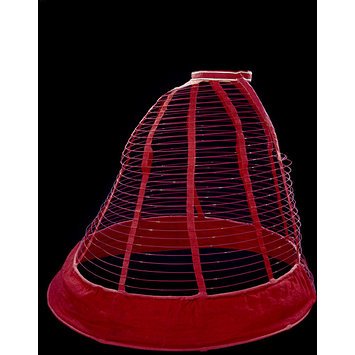
Crinoline. 1860-65. V & A Museum. T.150-1986.
It was the 1850s. Skirts were big. Transportation, not so much. Prior to elevated railways, streetcars, and subways, mass transit meant the omnibus, a horse-drawn wagon, often enclosed.
Crinolines (hoop skirts) gave lampoonists of the mid-19th century ample tongue-wagging material. Photographs were staged and prints distributed to make fun of the wide skirted fashion. Crowded public transportation just provided the perfect stage for denigration of the crinoline.
But anyone who’s actually worn a hoop skirt to work on a regular basis (I did for work in my early 20s) knows that they aren’t quite as difficult to manage as the 19th century press and modern brides make them out to be. I drove a manual pick-up truck in mine. The tipped rings collapse on each other when one sits. Yes, it provides extra width to the sides, but not so much to the front. Crinolines dangling from the sides of omnibuses in photographs are obviously a farce – no woman is going to dig under her dress in public for the crinoline’s buckle at her waist, and then reverse the process after disembarking the omnibus. Fishing the crinoline up between underpetticoat and overpetticoat and dress skirt is nearly impossible in the privacy of one’s bedroom, let alone a fetid nineteenth-century London street.

New York Public Library. Oct 2, 1858.

You will find the original of the image with the woman and omnibus in an online exhibition by Getty Images. They call it “Crinoline Delivery” and the text along with it is as follows: Ladies’ crinolines are loaded onto an omnibus going from Sloane Street to Fleet Street, London. London Stereoscopic Company Comic Series (Photo by London Stereoscopic Company/Getty Images) Here is the link to the exhibition: http://www.gettyimagesgallery.com/exhibitions/archive/london-through-a-lens.aspx
Thank you!
Admiring the persistence you put into your blog and detailed information you offer.
It’s great to come across a blog every once in a while that isn’t the same out of
date rehashed material. Fantastic read! I’ve saved your site and I’m adding your
RSS feeds to my Google account.
[…] via Pinterest, o quarto ainda, e Vintage […]